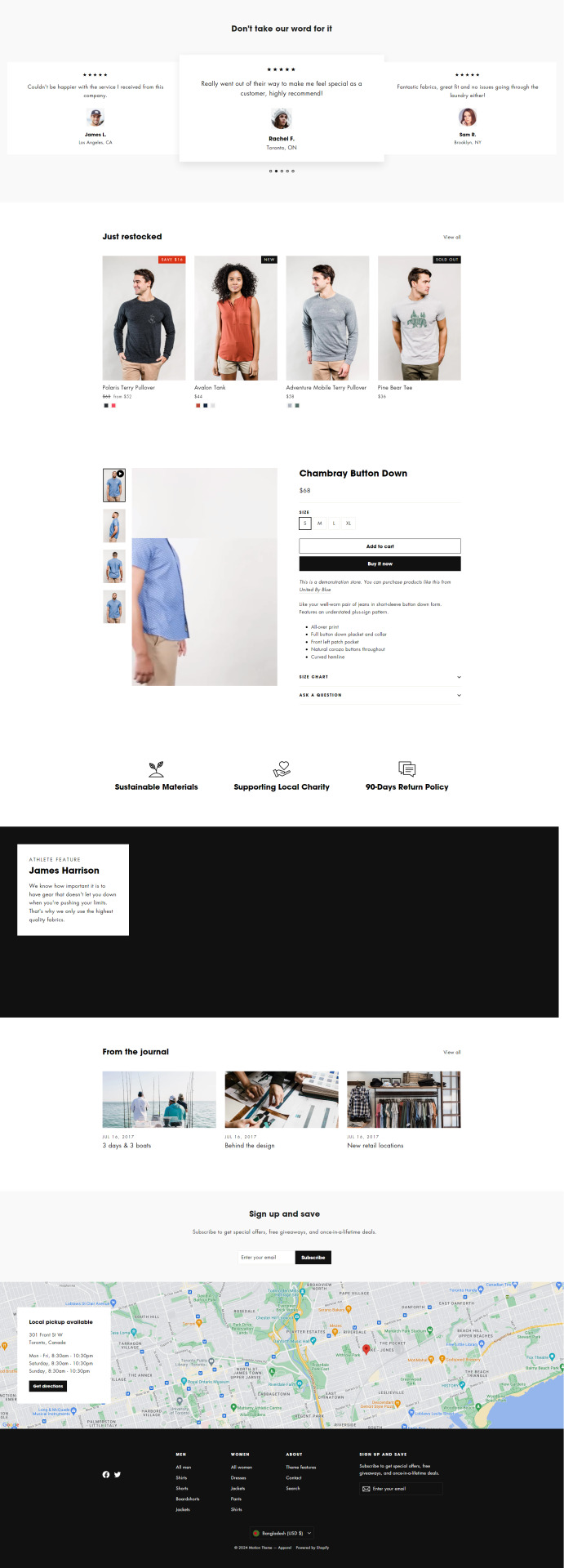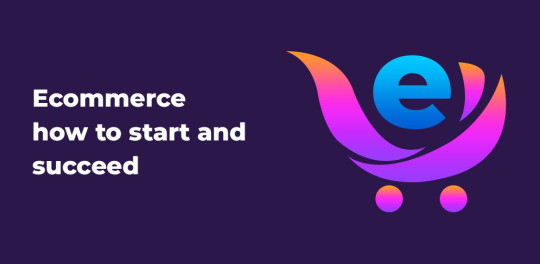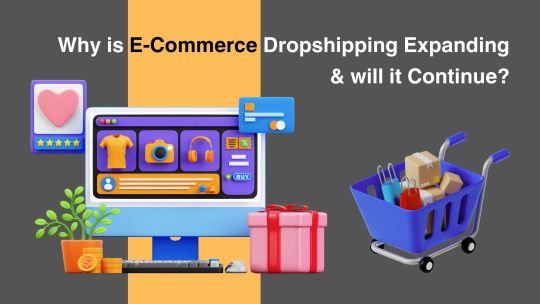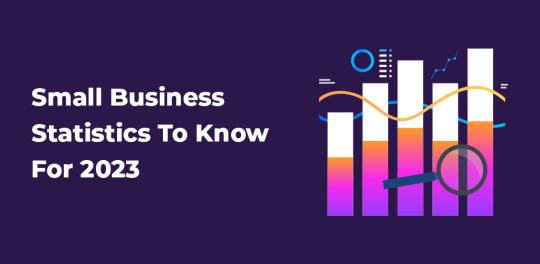#Ecommerce Platform for Dropshipping
Text
6 Best Dropshipping Ecommerce Platforms and Their Benefits
6 Best Dropshipping Ecommerce Platforms and Their Benefits
If you want to learn dropshipping, you should know that you need an Ecommerce platform.
If you want to learn more about dropshipping, Read more: What is Dropshipping, and How Do I Begin a Dropshipping Business? then continue reading
However, because there are so many Ecommerce platforms on the market right now, it can be difficult to find the best. Some may even claim to be the best, even if…

View On WordPress
0 notes
Text
Top 8 Strategies to take your eCommerce Product Images to the Next Level
In the eCommerce sector, where visuals play a crucial role in influencing consumer behavior, the importance of high-quality product images cannot be overstated. However, simply having clear photographs may not be enough to stand out in a crowded online marketplace. To truly captivate your audience and boost sales, consider enhancing your eCommerce product images with rich content.
Rich content goes beyond the basic visuals and incorporates additional elements such as descriptive text, interactive features, and multimedia elements. An Etilize data partner can make your eCommerce product images more appealing to your buyers.
Here are some strategies to take your product images to the next level:
1) Detailed Descriptions
Accompany your product images with detailed and compelling descriptions. Instead of just listing specifications, tell a story about the product. Explain its features, benefits, and how it can solve a problem for the customer. Use language that resonates with your target audience and highlights the unique selling points of the product. Etilize content can provide in-depth descriptions and attract your customers.
2) Interactive Hotspots
Implement interactive hotspots on your product images. These are clickable areas that provide additional information when users hover over or click on them. For example, if you sell clothing, you can add hotspots to showcase fabric details, sizing information, or styling tips. This interactive approach engages customers and provides a more immersive shopping experience.
3) 360-Degree Views
Consider incorporating 360-degree views of your products. Etilize product content can help you to provide product views from all angles. This allows customers to see the item from various angles, providing a more comprehensive understanding of its appearance and features. Many ecommerce platforms support 360-degree image functionality, enabling customers to virtually inspect the product as if they were holding it in their hands.
4) Product Videos
Create short product videos to showcase your items in action. Videos can highlight product features, demonstrate usage, and create a more dynamic presentation. Embedding videos alongside product images adds a multimedia dimension to your product pages, increasing engagement and building a stronger connection with potential buyers.
6) User-Generated Content
Encourage your customers to share their own images and experiences with your products. Feature user-generated content on your product pages to build trust and authenticity. This not only provides social proof but also allows potential buyers to see how real people are using and enjoying your products.
7) SEO-Optimized Alt Text
Don't overlook the importance of SEO for your product images. Use descriptive and keyword-rich alt text for your images to improve their visibility in search engine results. This not only enhances the discoverability of your products but also contributes to the overall search engine optimization of your ecommerce website.
8) Consistent Branding
Maintain a consistent brand identity across all your product images. This includes using a uniform style, color palette, and fonts. Consistency helps build brand recognition and trust among your audience.
Enhancing your eCommerce product images with rich content goes beyond the visual appeal. It involves creating a holistic and engaging shopping experience for your customers. By incorporating detailed descriptions, interactive elements, multimedia, and SEO optimization, you can elevate your product pages and make a lasting impression on potential buyers. Stay ahead in the competitive eCommerce landscape by investing in rich content that not only showcases your products but also tells a compelling story.
#ecommerce platform#varstreet#business software#sales quoting software#cpq software#dropshipping#value added reseller
6 notes
·
View notes
Text
Explore the advantages and disadvantages of using Shopify for dropshipping in 2024. Learn about Shopify's user-friendly interface, customization options, and scalability, along with considerations such as cost, transaction fees, and competition. Consider hiring Webgarh Solutions for expert Shopify dropshipping store development services to maximize your e-commerce success.
#shopify#dropshipping#ecommerce#shopify store#customization#shopify apps#payment gateways#ecommerce platforms#web development#shopify development#webgarh solutions
0 notes
Text


Shopify Store Design
Motion theme Customization.
#shopify#e commerce#elementor#landing pag#wordpress#shopifystore#shopify ecommerce development#shopifyexperts#shopify ecommerce platform#online store#Shopify one product store#shopify store design#Shopify apps#shopify tips#dropshipping
0 notes
Text
Is the e-commerce business profitable in 2023?
If you're launching an e-commerce business and want to get started, you must understand what an e-commerce store is. E-commerce is a method of digitally selling your product on the Internet. With an online store, you can sell your products or services anywhere on the globe.
The market size for eCommerce in 2022 was US$ 16.6 trillion, making e-commerce businesses the key to a successful business. It keeps growing since everyone is going digital and more people like to shop online.
The answer to your question is Yes! E-commerce businesses will be profitable in 2023. And every year it becomes more profitable. The reason is that more traffic on the internet means more sales and profit. Because everyone is on the internet, you just have to target your niche audience. You must have the best e-commerce platform for them as well as the best niche for your business.
How do you make an e-commerce business profitable?

If you want to make your e-commerce business profitable, you have to target a service and product niche that makes more profit. There are more steps to take to make your e-commerce business profitable.
Make a good brand value or awareness.
Choose the best platform for your e-commerce business that helps you grow.
Do marketing for your business, like social media marketing, and run Facebook ads or Google ads.
Give your customer the best experience and support, and make a connection with them.
Use customer data and activities to make your business better.
Those are the main steps for making your e-commerce business more profitable and building a good brand name or awareness.
The best profitable eCommerce business ideas (with low investment)
There are a lot of online businesses you can start, but I want to share the top 5 business ideas you can launch right away with no money.
Online books:-
You can create your e-books for free and sell them online if you have a creative mind and an interest in writing. You simply need to produce a book that readers will enjoy.
E-commerce store:-
You can start selling products online by setting up a free e-commerce store, regardless of whether you already run an offline business and wish to move it online. I'll let you know if an e-commerce system is suitable for your company. Because the majority of consumers purchase goods online, You can grow your business easily.
Selling handmade goods:
Many people have a creative side, produce excellent handmade goods, and desire to market their creations, making it possible for them to launch their own handmade products company without any investment.
Dropshipping:-
You can launch an online business even without any products. You can start a dropshipping business by simply selling other people's goods and making a profit. Simply use a platform on which to sell other goods. And you don't need money to start it. You can use QPe for this because it allows you to launch an e-commerce store for free.
Print on demand:
Once more, if you are creative and have strong design abilities, you can launch your own business. The business will take care of everything else; all you have to do is create designs for clothing and sell them. Canva makes designing simple. Start with Printify, Printful, etc.
If you want to start these businesses, you also need the best platform to grow them. There are many platforms, but I want to suggest QPe because it allows you to launch an online store for free in just a few minutes without any programming knowledge or experience. There are more reasons to use it.
The best platform to make your e-commerce business profitable
For start-ups, small business owners, and entrepreneurs, QPe provides free online stores. In a few seconds, an online store can be launched.
With QPe's content management system (CMS), it is simple to handle purchases, cataloged products, and user interactions with online retailers
The fastest-growing e-commerce platform is QPe. Online retailers can use QPe, an all-inclusive SaaS-based software solution, to manage their companies. without having any specific programming knowledge. Starting an online business is simple.
QPe provides a variety of themes, a QR Code For the Shop, a free catalog builder, the ability to upload an unlimited amount of products, analytical Tools, and more to assist you in starting an online store. QPe also provides a large selection of additional functions.
You can handle orders, manage your inventory, and take payments using a single point-of-sale (POS) management system. There are many design and product-adding options available to you.
With QPe, you can sell your goods without paying any commission fees.
Source:- https://www.goqpe.com/
#ecommerce website#ecommerce#ecommerce platform#online business#online store#profitable#dropshipping
0 notes
Text
Ecommerce how to start and succeed

Ecommerce has become an increasingly popular way to start a business in the UK. With the rise of online shopping, there has never been a better time to start your own ecommerce business. However, starting an ecommerce business can be a daunting task, especially if you are new to the world of online selling.
Before we take you on the tour of the key pointer’s to be kept in mind, let us understand who an Entrepreneur is.
Entrepreneurship refers to the process of starting and running a business venture, typically with the aim of creating value or generating profit. It involves identifying an opportunity in the market, developing a product or service that meets the needs of customers, and building a sustainable business model around it.
Entrepreneurship is characterized by creativity, risk-taking, innovation, and the ability to recognize and act on opportunities that others may overlook. It often involves overcoming challenges and obstacles, such as limited resources, market uncertainty, and competition.
Successful entrepreneurship requires a combination of skills and traits, such as leadership, communication, strategic thinking, financial management, and resilience. Entrepreneurs may operate in a variety of industries and sectors, from technology and finance to retail and healthcare.
Entrepreneurship is also associated with broader economic and social benefits, such as job creation, innovation, and economic growth. As such, it is often promoted by governments and institutions as a means of spurring economic development and improving living standards.
In this blog, we will discuss how to start and succeed in ecommerce in the UK.
Choose your niche
The first step to starting a successful ecommerce business is to choose your niche. A niche in a wider industry is a concentrated area of interest. For example, instead of selling clothing in general, you could specialize in selling vintage clothing or sustainable fashion. By choosing a niche, you can stand out from your competitors and appeal to a specific audience.
Conduct market research
Once you have chosen your niche, it is important to conduct market research. This will help you to understand your target audience and competition. Look at what other businesses in your niche are doing, and identify gaps in the market that you can fill. You can also use tools like Google Trends and social media analytics to see what people are searching for and talking about in your niche.
Create Your Business Plan
Your business plan should include your goals, strategies, target audience, and financial projections. It should also outline how you plan to market your ecommerce business, how you’ll handle customer service, and how you’ll manage your inventory and shipping. Your business plan will be your roadmap for success, so take the time to create a detailed and well-thought-out plan.
Register Your Business
After your business strategy is in place, you must register your company. This will involve choosing a business structure, registering with HM Revenue and Customs (HMRC), and registering for VAT (if your annual turnover is over £85,000).
Choose your ecommerce platform
There are many ecommerce platforms to choose from, including Shopify, WooCommerce, and Magento. Each platform has its own strengths and weaknesses, so it is important to choose one that is best suited for your business. Take into account elements like cost, scalability, and simplicity of use.
Build your online store
Once you have chosen your ecommerce platform, it is time to build your online store. This will involve designing your website, adding products, and setting up payment and shipping options. You can either do this yourself or hire a web developer to help you.
Set Up Your Payment Gateway
You’ll need to set up a payment gateway to allow your customers to pay for their purchases securely. Popular payment gateways include PayPal, Stripe, and SagePay.
Secure your website
Security is critical for any ecommerce business. Make sure your website is secure by using SSL encryption and regularly updating your software and plugins.
Get an accountant
It’s important to keep your finances in order, so consider hiring an accountant to help you manage your finances, taxes, and bookkeeping.
Get business insurance
Business insurance is essential to protect your business from unforeseen events, such as theft, fire, or natural disasters.
Launch your website
Once you have completed all the necessary steps, it’s time to launch your website and start selling!
Market Your Online Store
Marketing is essential to the success of your ecommerce business. You can use a variety of marketing channels, such as social media, email marketing, and search engine optimization (SEO), to promote your online store and attract customers.
Manage Your Inventory and Shipping
As your business grows, you’ll need to manage your inventory and shipping efficiently. You can use inventory management software to track your stock levels and automate your shipping process.
Provide Excellent Customer Service
Finally, provide excellent customer service to keep your customers happy and coming back for more. Respond to customer inquiries promptly, offer refunds or exchanges when necessary, and go above and beyond to make your customers feel valued.
Analyze and optimize
Finally, it is important to analyze your ecommerce business and optimize it for success. Track the sales and visitors to your website using programmes like Google Analytics. Look for areas where you can improve, such as website design, product selection, and customer service. Continuously make improvements to your business to ensure its success.
In conclusion, starting an ecommerce business in the UK can be a rewarding and lucrative endeavor. By choosing your niche, conducting market research, choosing the right ecommerce platform, building your online store, marketing your business, and analyzing and optimizing for success, you can build a successful ecommerce business in the UK. You’ll be well on your way to creating a thriving online store that attracts loyal customers and generates revenue for years to come.
To begin with, you definitely need a straightforward internet sales channel for your goods. For this, a straightforward store template on a reliable drop shipping platform like Avasam works just well.
To assist you, we created a tutorial for setting up your account on drop shipping platform – Avasam. Although it can take you a while to get going, watch how much time you invest in the beginning.
Good luck!
#uk dropshipping suppliers#ecommerce businesses#verified suppliers#dropshipping platform with uk based suppliers#uk
0 notes
Text
https://www.worklooper.com/post/best-e-commerce-platforms-for-dropshipping
0 notes
Text
#online boutique#boutique#boutique shopping#boutique store#boutique dropshipping clé en main#boutique sunshine coast#ecommerce business#ecommerce solutions#ecommerce web design#ecommercewebsite#online store#ecommerce platform#ecommerce store builder#ecommerce site#small business#ecommerce#boutique d&039;applications apple#boutique en ligne#onlineshopping#sustainablefashion#fashionstyle#souvenir#designers
0 notes
Text
like i cannot stress enough that the ease of use that Etsy had is no longer enough to keep me on their platform. Even paying for Etsy plus, paying for etsy ads, and offering free shipping was not off setting my costs to ....do all of that. On top of that, Etsy takes 6.5% per transaction fee (per item sold) PLUS 6.5% of the shipping charge.
also the only reason I have gotten Star Seller status at ALL is because my traffic and sales were so slow that it was nearly impossible not to get it at that point.
It's a dying ecommerce platform for handmade stuff, and it has been for a long time, and it's going to only be dropshippers soon -- which dropshipping is not a bad thing! nor do I hate dropshippers! -- but on a platform that was and is marketed as a handmade platform, it is bad.
Like, even paying for etsy ads they were not bringing in the traffic they said they would. You know what brought in the traffic? Tumblr. Between me actively pushing my posts and you all being absolutely wonderful humans, you were the reason my traffic ever existed. So I think it's time for me to leave Etsy behind and we can move to something that works better for all of us.
I'm hoping that with my own website I can start to offer international shipping again. I really miss sending packages all over the world, but Etsy made it nigh impossible to ship to other countries with their fees.
anyway I feel strongly enough about my displeasure with Etsy that I am willing to go through the discomfort of growing pains to migrate to a new platform.
hash tag girl boss or whatever
266 notes
·
View notes
Text

For ecommerce platform development remember one name only PENNEP
Visit the website https://www.pennep.com/services/e-commerce-development
2 notes
·
View notes
Text
Best Passive Income Streams Opportunities 🤑
💰💻 Learn some insider secrets to generate passive income online! Buckle up, because I'm about to drop some knowledge bombs that will blow your mind! Let's dive in and discover the incredible opportunities that await you in the digital world! 🚀
1️⃣ Did you know that affiliate marketing is one of the most popular ways to earn passive income? 🤝 By promoting products and earning a commission for each sale you make, you can turn your online presence into a money-making machine! 💸
2️⃣ Have you ever considered creating and selling an online course? 🎓 Share your expertise and passion with the world! Whether it's teaching photography, cooking, or even underwater basket weaving 🏊♂️🧺, there's an audience out there hungry for knowledge.💡
3️⃣ Don't underestimate the power of e-commerce! 🛍️ With dropshipping, you can set up an online store without worrying about inventory or shipping. Simply find hot products, partner with suppliers, and let them handle the logistics. All you have to do is market your store, and every sale becomes a sweet stream of passive income!💰
4️⃣ Picture this: you're a successful blogger with a loyal following. 💻💬 Why not monetize your blog by accepting sponsored posts or placing strategic ads? Ad networks, like Google AdSense, can help you earn money every time someone clicks on an ad displayed on your site. It's like turning your blog into a virtual cash cow! 🐮💸
5️⃣ Have you ever heard of print-on-demand? 🖨️👕 It's a game-changer! Create unique designs for t-shirts, mugs, phone cases, and more. Partner with a print-on-demand service, and they'll handle the production and shipping for you. All you have to do is unleash your creativity and watch the passive income flow! 🎨💲
6️⃣ Did you know that YouTube is not just a platform for cat videos? 🐱🎥 It's a goldmine for content creators! By monetizing your videos through ads or brand partnerships, you can turn your passion into a passive income powerhouse! 🚀🎥
Finally, the internet is bursting with opportunities to generate passive income. 💥💸 So find your passion, leverage your skills, and let the digital world become your profitable business!
🎯💡 Take action and start your journey towards financial freedom! Don't forget to check out my ultimate online business guide! 🌐 It's packed with even more insider tips and tricks to help you create multiple passive income streams from the internet.
#onlinebusiness #passiveincome #makemoneyonline #earnmoneyonline #makingmoneyonline #earningmoneyonline #workfromhome #homebusiness #onlinebusinessideas #digitalmarketing #onlinemarketing #internetmarketing #emailmarketing #affiliatemarketing #onlinestore #ecommerce #dropshipping #youtuber #youtubechannel #youtubemarketing #contentcreator #contentcreation #digitalcreator #digitalproduct #blogger #makemoneyblogging #monetizeyourblog #printondemand #influencermarketing #googleads #googleadsense #adsense
#work from home#affiliate marketing#make money online#home business#make money with affiliate marketing#online marketing#online business#digital marketing#blogger#marketing#passive income
5 notes
·
View notes
Text
How to Turn Your Online Business Dreams into Reality


Introduction: The Digital Frontier of Entrepreneurship
Selecting a Niche and Business Model: The Foundation of Success
Building Your Online Platform and Brand: Your Digital Headquarters
Creating High-Demand Products and Services: Delivering Value to Your Audience
Implementing Effective Marketing Strategies: Attracting Targeted Traffic
Diversifying Revenue Streams for Maximum Profits: Building Financial Stability
Optimizing for Maximum Profitability Long-Term: Building a Sustainable Business
Conclusion: Turning Dreams into Reality
True successful story
Introduction: The Digital Frontier of Entrepreneurship
In today's digital age, the rise of the internet and technology has revolutionized the way we do business. It has opened a world of opportunities for entrepreneurs to start and run their own businesses online. Online businesses offer flexibility, scalability, and the potential for global reach. This comprehensive guide will provide you with a step-by-step framework for building a profitable online business from the ground up. Whether you want to start a side business or build a full-time online empire, follow this ultimate guide to turn your idea into a thriving, sustainable online business. With focus, grit, and commitment to continuous improvement, you can build the profitable online business of your dreams.
Selecting a Niche and Business Model: The Foundation of Success
The foundation of every successful online business is choosing a profitable, in-demand niche and a business model tailored to your goals. Select a niche you're passionate about; this will make creating content a breeze. Conduct thorough keyword research to assess search volume and demand. Join relevant online communities to connect with your audience and understand their needs. Evaluate direct competitors in the niche and aim for less saturated niches or unique angles. Consider affiliate marketing potential, as some niches offer higher commissions. Assess opportunities to create multiple products and monetize in diverse ways. Examples of popular online business niches include health, fitness, personal finance, pet care, tech, travel, content marketing, home design, spirituality, language learning, and more.
Choose a business model that complements your niche and provides multiple income stream opportunities. Many successful online businesses incorporate 3-4 monetization models. Some of the best online business models to consider include:
1. Blogging: Make money with display ads, affiliates, and branded products.
2. Online Courses: Sell your knowledge and expertise as courses.
3. Dropshipping: Curate and sell products without inventory.
4. Affiliate Marketing: Earn commissions promoting other companies' products.
5. Information Products: Sell online books, templates, checklists, and more.
6. Virtual Services: Provide consulting, freelancing, coaching, or other services.
7. Subscription Membership Site: Offer exclusive content or tools for a monthly fee.
8. E-commerce Store: Sell physical products, merchandising, and more.
Your choice should complement your niche and offer multiple income streams. Many successful online businesses incorporate 3-4 monetization models.
Building Your Online Platform and Brand: Your Digital Headquarters
Your website or blog will serve as the headquarters for your online business. Invest time upfront in creating an optimized, professional-looking platform. Purchase a domain name that matches your brand, ideally a .com if available. Select reliable web hosting with optimal speed and uptime. Install WordPress or ecommerce platforms like Shopify or WooCommerce. Design an on-brand, mobile-responsive theme that conveys your style. Include essential pages like Home, About, Contact, Services, Blog, and Shop. Set up email marketing and analytics to capture leads and track traffic data. Create visually branded assets such as logos, color palettes, fonts, and graphics. Ensure a cohesive user experience across all touchpoints. If you lack web development skills, consider hiring a freelance designer to bring your vision to life. Continually optimize your website for higher traffic, leads, and sales over time. This includes technical enhancements, user experience improvements, and page speed optimizations.
Creating High-Demand Products and Services: Delivering Value to Your Audience
The key to running a profitable online business is consistently creating products and services that deliver extreme value to your audience. Popular digital products you can create include online courses, eBooks, guides, checklists, software, premium memberships, virtual events, video tutorials, templates, and more. When brainstorming products, look for opportunities to simplify lives, save time, educate, entertain, or improve outcomes for your target customers. Leverage your expertise and tap into the skills of others to create premium offerings.
High-value services like consulting, freelancing, coaching, and more can also be extremely lucrative. Promote your services through your website and social platforms. Structure your offerings to passively earn income over time, such as online courses that continually generate sales vs. 1-on-1 services that require ongoing effort. Deliver an excellent user experience across your products and relentlessly optimize based on feedback to foster raving fans who refer others.

Implementing Effective Marketing Strategies: Attracting Targeted Traffic
Once your online platform and offerings are ready, it's time to start attracting targeted traffic using proven marketing tactics. A diverse marketing mix is key. Some of the top strategies include:
1. Content Marketing: Create engaging blog posts, videos, and visual content.
2. SEO: Optimize your website for search engines through on-page optimization and link-building.
3. PPC Ads: Utilize platforms like Google, Facebook, Instagram, and YouTube for pay-per-click advertising.
4. Email Marketing: Build your email list with lead magnets, newsletters, and automation.
5. Social Media Marketing: Employ organic and paid tactics to engage your audience.
6. Affiliate Marketing: Recruit others to promote your products and earn commissions.
7. Influencer Partnerships: Collaborate with relevant influencers in your niche.
8. Live Events: Host local meetups or virtual events to connect with your audience.
9. Podcast Guest Appearances: Grow your authority and reach new audiences.
10. Retargeting Ads: Remarket to previous site visitors across the web.
Start by focusing on 1-3 core channels, then expand your efforts over time. Pay-per-click and social ads can help quickly scale an audience, while SEO and content creation tend to be most cost-effective in the long-term. Leverage tools like Google Analytics, Facebook Business Suite, and landing page builders to optimize results across all campaigns. Don't hesitate to enlist help from digital marketing agencies and specialists.
Diversifying Revenue Streams for Maximum Profits: Building Financial Stability
Generating multiple streams of revenue is key for building a highly profitable online business. Diversification reduces risk and provides stability as each income channel goes through ups and downs. Here are some of the most lucrative online business revenue models:
1. Product/Service Sales: Your core monetization stream. Ensure competitive yet profitable pricing.
2. Advertising: Display ads, sponsorships, native advertising, etc. Set up Google Ad Manager.
3. Affiliate Marketing: Promote other company's products for commissions. Join affiliate networks.
4. Memberships/Subscriptions: Offer exclusive benefits, content, or tools for a monthly fee.
5. Events: Sell tickets for online or in-person events and training programs.
6. Dropshipping: Curate and sell products without holding inventory.
7. Physical Merchandise: Sell branded products with print-on-demand services.
8. Consulting/Freelancing: Sell your skills and expertise through 1-on-1 services.
9. Tip Jars/Donations: Allow fans to tip or donate to show support.
Aim to generate income from both active efforts like service packages and passive streams like online courses that earn as you sleep. Automate processes wherever possible to scale income without increasing workload proportionally. Reinvest profits back into growing your business and diversifying income channels to create an unstoppable snowball effect over time.



Optimizing for Maximum Profitability Long-Term: Building a Sustainable Business
Launching a profitable online business is an important first step. However, creating systems and processes that enable high profitability long-term is vital for sustaining growth. Here are some best practices for optimizing operations and profitability:
- Obsessively track KPIs and metrics for all marketing channels and funnels. Analyze data to optimize underperforming areas.
- Create excellent customer support systems. Provide prompt, personalized support to increase satisfaction and referrals.
- Automate repetitive tasks wherever possible with tools like Zapier. Automate lead collection, customer onboarding, analytics, inventory management, etc.
- Systematize your product creation process to quickly test and validate new product ideas, then scale those that resonate.
- Document your systems and processes so future hires can replicate them. This includes SOPs for customer service, product fulfillment, etc.
- Build a skilled team over time by hiring virtual assistants, freelancers, agencies, and eventually full-time employees. Focus on higher-level strategy.
- Maintain work-life balance as a long-term entrepreneur. Make time for adequate rest, leisure, and self-care to avoid burnout.
By staying agile, embracing innovation, and relentlessly providing value to your audience, you can build an online business that delivers meaningful income for decades to come.



Conclusion: Turning Dreams into Reality
Starting and running a profitable online business takes consistent effort and persistence. However, by zeroing in on a niche, selecting the right model, crafting high-value offerings, implementing diverse marketing strategies, diversifying your revenue streams, and optimizing for maximum efficiency, you can build an online business that provides freedom and fulfillment for years to come. Remember to stay obsessively focused on understanding and serving your target audience. Combine your passion with grit, resilience, and creativity. With the right mindset and business foundations in place, you have immense potential to build a thriving online business that stands out and makes a lasting impact. The time to stop dreaming and start taking action is now. Follow this comprehensive guide to turn your online business idea into reality, step-by-step. You can build an online empire that allows you to live life on your terms. The possibilities are truly endless if you commit to continuous learning and improvement. Let this guide spark the fire within and set you on the path to online business success. Start pursuing your online entrepreneur dream today.


True successful story
To illustrate the principles and strategies discussed in this comprehensive guide, let's delve into the inspiring true story of Pat Flynn and his online business, Smart Passive Income.
Smart Passive Income - About Pat Flynn
Background:
Pat Flynn was once an aspiring architect who unexpectedly found himself laid off during the economic downturn in 2008. Faced with uncertainty, he turned to the online world to seek alternative income sources. His journey began with a blog, which he aptly named Smart Passive Income (SPI).
Selecting a Niche and Business Model:
Pat recognized that there was a significant demand for information about creating online businesses and generating passive income. He was passionate about sharing his experiences, both successes and failures, and helping others navigate the world of online entrepreneurship. Pat's chosen niche was personal finance, but his business model extended beyond blogging.
Building Your Online Platform and Brand:
Pat invested in creating a professional-looking platform for SPI. He purchased a domain name, set up reliable web hosting, and designed an appealing website. His commitment to providing value was evident through the content he produced on his blog, podcast, and YouTube channel. His brand, Smart Passive Income, became synonymous with transparency, authenticity, and actionable advice.
Creating High-Demand Products and Services:
One of Pat's significant successes came from his creation of online courses and informational products. He developed courses on topics like email marketing, affiliate marketing, and podcasting, leveraging his expertise and audience trust. These products delivered immense value to his audience and contributed significantly to his income.
Implementing Effective Marketing Strategies:
Pat's marketing strategy was built on content marketing, podcasting, and email marketing. He consistently produced high-quality blog posts and podcasts, which not only attracted a dedicated audience but also positioned him as an industry expert. His email list grew as he offered valuable lead magnets and nurtured his subscribers.
Diversifying Revenue Streams for Maximum Profits:
Pat's income streams diversified over time. In addition to course sales, he earned from affiliate marketing, book sales, and speaking engagements. He also ventured into software development, creating tools like the Smart Podcast Player. This diversification provided stability and mitigated risk.
Optimizing for Maximum Profitability Long-Term:
Pat was relentless in optimizing his operations. He regularly analyzed data and user feedback to improve his products and content. His team expanded as the business grew, allowing him to focus on strategic decision-making. Pat prioritized work-life balance, emphasizing family and well-being.
Conclusion:
Pat Flynn's journey from unexpected job loss to the creation of a successful online business, Smart Passive Income, serves as an inspiring real-life example of the principles discussed in this guide. His dedication to providing value, commitment to continuous improvement, and willingness to diversify income streams are key takeaways for anyone aspiring to build a thriving online business. Pat's story reminds us that with the right mindset and a clear vision, online entrepreneurship can lead to a fulfilling and prosperous career.


Read the full article
#business-model#guide#marketing#niche#online-business#products#profitability#revenue#services#Success
4 notes
·
View notes
Text
How Quoting Applications Elevate IT VAR Operations?
In the dynamic and competitive landscape of information technology value-added resellers (IT VARs), efficiency and accuracy in quoting are paramount. Quoting applications have emerged as indispensable tools that not only streamline the quoting process but also significantly elevate overall IT VAR operations.
In this article, we will explore how quoting applications serve as catalysts for success in the IT VAR sector.
Precision and Accuracy in Quotes
Quoting is a critical aspect of IT VAR operations, where precision is non-negotiable. Sales quoting software brings a level of accuracy that surpasses traditional methods. These applications are designed to handle complex pricing structures, discounts, and configurations specific to the IT industry. As a result, IT VARs can generate quotes with confidence, knowing that pricing information is accurate and reflective of the dynamic market conditions.
Streamlining Complex Configurations
In the IT realm, products often come with intricate configurations, compatibility requirements, and various add-ons. Quoting applications simplify the complexity associated with configuring quotes for diverse IT solutions. By leveraging predefined product configurations and rules, these applications ensure that the quoted solutions are not only accurate but also align with the specific needs and preferences of the customers.
Faster Turnaround Times
Time is of the essence in the IT VAR business, where swift responses to customer inquiries can make the difference between winning and losing a deal. Quoting applications significantly reduce the turnaround time for generating quotes. Automated processes and real-time pricing updates enable IT VARs to respond promptly to customer requests, fostering a responsive and agile business environment.
Enhancing Collaboration and Communication
A quoting application for IT VAR facilitates seamless collaboration among various departments within an organization. Sales teams can work in tandem with procurement, finance, and other relevant departments to ensure that the quotes generated are not only accurate but also aligned with organizational goals. Additionally, these applications often come with communication features that enable easy sharing of quotes with clients, promoting transparency and effective client engagement.
Customization for VAR-specific Needs
One of the key advantages of quoting applications for IT VARs is their ability to cater to the specific needs of the industry. These applications are often customizable, allowing VARs to adapt them to their unique business processes. Whether it's incorporating specific vendor information, adjusting pricing structures, or accommodating industry-specific nuances, quoting applications empower IT VARs to tailor their quoting processes for optimal results.
Real-time Market Intelligence
Quoting software for IT reseller leverages real-time data and market intelligence, providing IT VARs with a competitive edge. These applications can integrate with pricing databases, track market trends, and adjust quotes accordingly. This not only ensures that IT VARs stay competitive in terms of pricing but also enables them to make informed decisions based on the latest market dynamics.
Conclusion
In the fast-paced world of IT VARs, where agility and accuracy are paramount, quoting applications emerge as game-changers. By elevating precision, streamlining complex configurations, and facilitating faster turnaround times, these applications empower IT VARs to stay ahead of the competition.
As the IT landscape continues to evolve, investing in advanced quoting applications along with an eCommerce platform is not just a matter of convenience but a strategic imperative for IT VARs looking to thrive in a dynamic and competitive market.
#ecommerce platform#varstreet#business software#cpq software#ecommerce#sales quoting software#ecommerce software#punchout catalog#punchout catalog solution#dropshipping
0 notes
Text
Discover the perfect e-commerce solution with Shopify vs WooCommerce dropshipping. Explore the benefits, costs, and customization options. For expert Shopify dropshipping store development services, trust Webgarh Solutions to elevate your online business with tailored solutions and skilled developers.
#shopify dropshipping store#hire shopify dropshipping developer#custom dropshipping store#webgarh solutions#shopify vs woocommerce#dropshipping comparison#ecommerce platform#shopify development#woocommerce customization#web development#ecommerce solutions#custom dropshipping#webgarh experts
0 notes
Text
What Does Ecommerce home page template Mean?
When you plan on providing digital products you probably don’t have to have a full fledged ecommerce platform. A digital product might be a thing like an ebook, online course, audio file, video file, or software application.
Marketers and developers are actually starting to really feel the mobile speed crunch. Mobile users assume pages on their own mobile devices to load faster than desktop.
Magic Spoon, a breakfast brand, does an excellent position portraying its products’ texture on its ecommerce site. The layout features a journal-like construction, which has a sparking color palette and detectable specifics powering each individual click and scroll.
logo created for fashion e commerce website working with a simple script font model and skinny feminin model as the most crucial thought should be to offer Ladies outfits
Given the gravity of this determination, Kimp delivers you a guidebook on designing Ecommerce logos in 2021.
Simply because nearly every single business contains a logo, generating your own ecommerce logo alerts to customers that your online store is legitimate and credible.
The logo had been designed before which was Unused and client observed it and acquired it for his or her new eCommerce company. We both of those are adore the SD mark! by Graphaety ™
Video & movement graphics for partaking content material & adsKimp Video – Video & motion graphics for participating content & ads
You will need to use a paid application to take full advantage of Amazon FBA integration and dropshipping. Many fulfillment centers offer you free WooCommerce integration, nevertheless some could involve customized development for an extra cost.
There are ten themes (all free) offered within the admin. You would possibly need tiny familiarity with HTML and CSS given that the theme customizer doesn’t Have got a drag and drop functionality.
The In addition plan is $29/month and involves features like deserted cart email, personalised products, and ratings and reviews. The Top ecommerce marketplace quality Plan is $79/month and contains all that furthermore genuine-time shipping prices.
You can use free applications to incorporate Amazon two way sync and Amazon Checkout. You’ll will need paid out applications to manage items like Amazon FBA, fulfillment center and dropshipping integrations, eBay 2 way sync, evaluate snippet structured data, email marketing automation, and print on desire. You’ll require custom development if you would like integrate Adobe Commerce with WordPress.
For the small business over a spending plan, Sellfy is a good starting level. It provides you with anything you might want to get started selling online – regardless of whether you promote physical or digital products. It’s not a perfect solution at scale, although.
This beautifully designed ecommerce store incorporates a theme with a lot of white Room, which helps present the goods more prominently. It has an incredibly neat and clear design, making the website glimpse really Experienced and sophisticated.
3 notes
·
View notes
Text
Small business statistics to know for 2023

Starting your own business can be an exciting and rewarding experience, but it requires careful planning and hard work. Here are some things to consider if you’re thinking about starting your own business:
Identify a need or a problem that your business can solve: Think about the things that you’re passionate about, and try to identify a need in the market that your business can fulfill. This could be a product or service that you’re passionate about and believe in.
Research your market and competition: Conduct research to understand your target market and the competition. This will help you to identify your unique selling proposition and develop strategies to differentiate your business from others.
Develop a business plan: A business plan will help you to outline your business goals, strategies, and financial projections. It’s important to have a clear understanding of your business’s financial needs and how you plan to fund it.
Decide on a legal structure: Determine the legal structure of your business, such as a sole proprietorship, partnership, limited liability company (LLC), or corporation. This will affect your liability, taxes, and legal responsibilities.
Register your business: Register your business with the appropriate government agencies, such as the Internal Revenue Service (IRS) and the Secretary of State. You may also need to obtain licenses and permits, depending on your industry and location.
Set up your business infrastructure: Set up your business infrastructure, including your office or workspace, technology, and accounting systems.
Develop your brand: Develop your brand identity, including your logo, website, and marketing materials. This will help you to establish a strong presence in the market and build brand recognition.
Start your company: When you’ve finished all the requirements, it’s time to start your company. This is an exciting time, but it’s important to be patient and persistent as you work to establish and grow your business.
Remember, starting your own business is a journey, not a destination. Be prepared to learn and adapt as you go, and be willing to take risks and make mistakes along the way. With hard work, dedication, and perseverance, you can build a successful business and achieve your entrepreneurial dreams.
Here are 10 small business statistics you need to know for 2023 in the UK:
As of 2021, there were 6 million small businesses in the UK, which accounts for 99.3% of all businesses in the country.
The number of new businesses being registered in the UK has been increasing year-on-year, with 780,000 new businesses being registered in 2021.
The UK government’s Small Business Grants Fund provided over £11 billion in grants to small businesses during the COVID-19 pandemic.
31% of small businesses in the UK have reported an increase in revenues since the COVID-19 pandemic, while 32% have reported a decrease.
The most common reason for small business failures in the UK is cash flow problems, with 82% of failed businesses citing this as a reason for failure.
Small businesses in the UK are increasingly using social media to market their products and services, with 87% of small businesses using social media to promote their businesses in 2021.
Cyber security is a growing concern for small businesses in the UK, with 46% of businesses experiencing a cyber-attack or data breach in the past year.
Small businesses in the UK are increasingly adopting digital technologies to improve their operations, with 74% of small businesses saying that digital technology has improved their business in 2021.
57% of small businesses in the UK say that they have been negatively impacted by Brexit, while 23% say that they have been positively impacted.
Small Businesses Create Jobs?
Small businesses are defined as those with fewer than 50 employees, and they operate across a range of industries and sectors. Many small businesses are family-owned and operated, and they provide valuable services and products to their local communities.
Small businesses in the UK employ around 16 million people, which is around 60% of all private sector employment in the country.
According to the UK government’s business statistics, there were 6.0 million small businesses (defined as those with 0-49 employees) in the UK as of 2020. This accounts for 99.3% of all businesses in the UK.
It’s important to note that this number can vary depending on how small businesses are defined, and there are other ways to categorize businesses by size, such as based on annual turnover or balance sheet total.
Small businesses play a crucial role in the UK economy, and they are responsible for creating a significant portion of jobs in the country. According to the Federation of Small Businesses (FSB), small businesses accounted for 99.3% of all private sector businesses in the UK in 2020, and they employed an estimated 13.8 million people, which represents around 60% of all private sector employment.
In addition to creating jobs, small businesses also contribute to the economy in other ways, such as generating tax revenues, driving innovation and competition, and supporting economic growth and development. Therefore, supporting and encouraging the growth of small businesses is critical to the continued success and prosperity of the UK economy.
The Main Engines of Global Economic Development Are Small and Medium-Sized Companies
Small and medium-sized businesses (SMBs) have been recognized as major drivers of global economic growth, particularly by the UK market. SMBs play a crucial role in creating jobs, driving innovation, and contributing to the overall growth of the economy.
According to the UK government, SMBs account for over 99% of all businesses in the UK and are responsible for more than half of the country’s employment. Similarly, in the US, SMBs account for more than 99% of all businesses and employ nearly half of the private sector workforce.
SMBs also contribute significantly to innovation and new product development, driving technological advancements and improving the quality of products and services. Many successful startups have been launched by entrepreneurs with innovative ideas and a strong drive to succeed.
Avasam is a drop-shipping platform to look forward to achieving your dreams.
#uk dropshipping suppliers#dropshipping store#ecommerce businesses#verified suppliers#dropshipping platform with uk based suppliers
0 notes